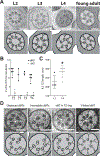Cell type-specific structural plasticity of the ciliary transition zone in C. elegans
- PMID: 30681171
- PMCID: PMC6922583
- DOI: 10.1111/boc.201800042
Cell type-specific structural plasticity of the ciliary transition zone in C. elegans
Abstract
Background information: The current consensus on cilia development posits that the ciliary transition zone (TZ) is formed via extension of nine centrosomal microtubules. In this model, TZ structure remains unchanged in microtubule number throughout the cilium life cycle. This model does not however explain structural variations of TZ structure seen in nature and could also lend itself to the misinterpretation that deviations from nine-doublet microtubule ultrastructure represent an abnormal phenotype. Thus, a better understanding of events that occur at the TZ in vivo during metazoan development is required.
Results: To address this issue, we characterized ultrastructure of two types of sensory cilia in developing Caenorhabditis elegans. We discovered that, in cephalic male (CEM) and inner labial quadrant (IL2Q) sensory neurons, ciliary TZs are structurally plastic and remodel from one structure to another during animal development. The number of microtubule doublets forming the TZ can be increased or decreased over time, depending on cilia type. Both cases result in structural TZ intermediates different from TZ in cilia of adult animals. In CEM cilia, axonemal extension and maturation occurs concurrently with TZ structural maturation.
Conclusions and significance: Our work extends the current model to include the structural plasticity of metazoan transition zone, which can be structurally delayed, maintained or remodelled in cell type-specific manner.
Keywords: C. elegans; axoneme; cilia; microtubule; transition zone.
© 2019 Société Française des Microscopies and Société de Biologie Cellulaire de France. Published by John Wiley & Sons Ltd.
Figures



References
MeSH terms
Grants and funding
- CSCR16FEL008/New Jersey Commission on Spinal Cord Research
- P40 OD010440/OD/NIH HHS/United States
- S10 RR029300/RR/NCRR NIH HHS/United States
- SF349247/Simons Foundation
- R01 DK116606/DK/NIDDK NIH HHS/United States
- DK116606/DK/NIDDK NIH HHS/United States
- DK059418/DK/NIDDK NIH HHS/United States
- S10 OD019994/OD/NIH HHS/United States
- OD010943/NIH Office of the Director
- P40 OD010440/CD/ODCDC CDC HHS/United States
- R24 OD010943/OD/NIH HHS/United States
- P41 GM103310/GM/NIGMS NIH HHS/United States
- R01 DK059418/DK/NIDDK NIH HHS/United States
- R24 RR012596/RR/NCRR NIH HHS/United States
- F00316/Agouron Institute
LinkOut - more resources
Full Text Sources

